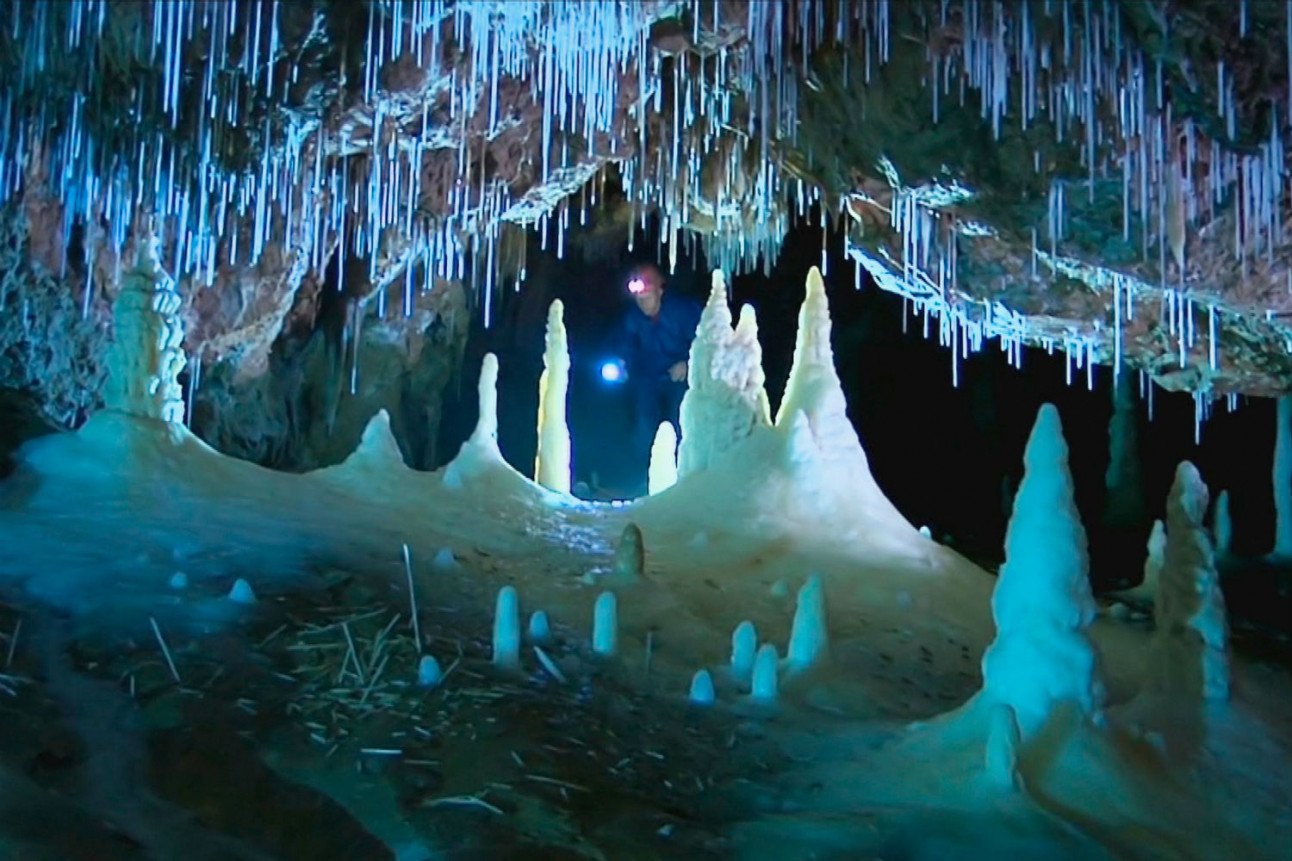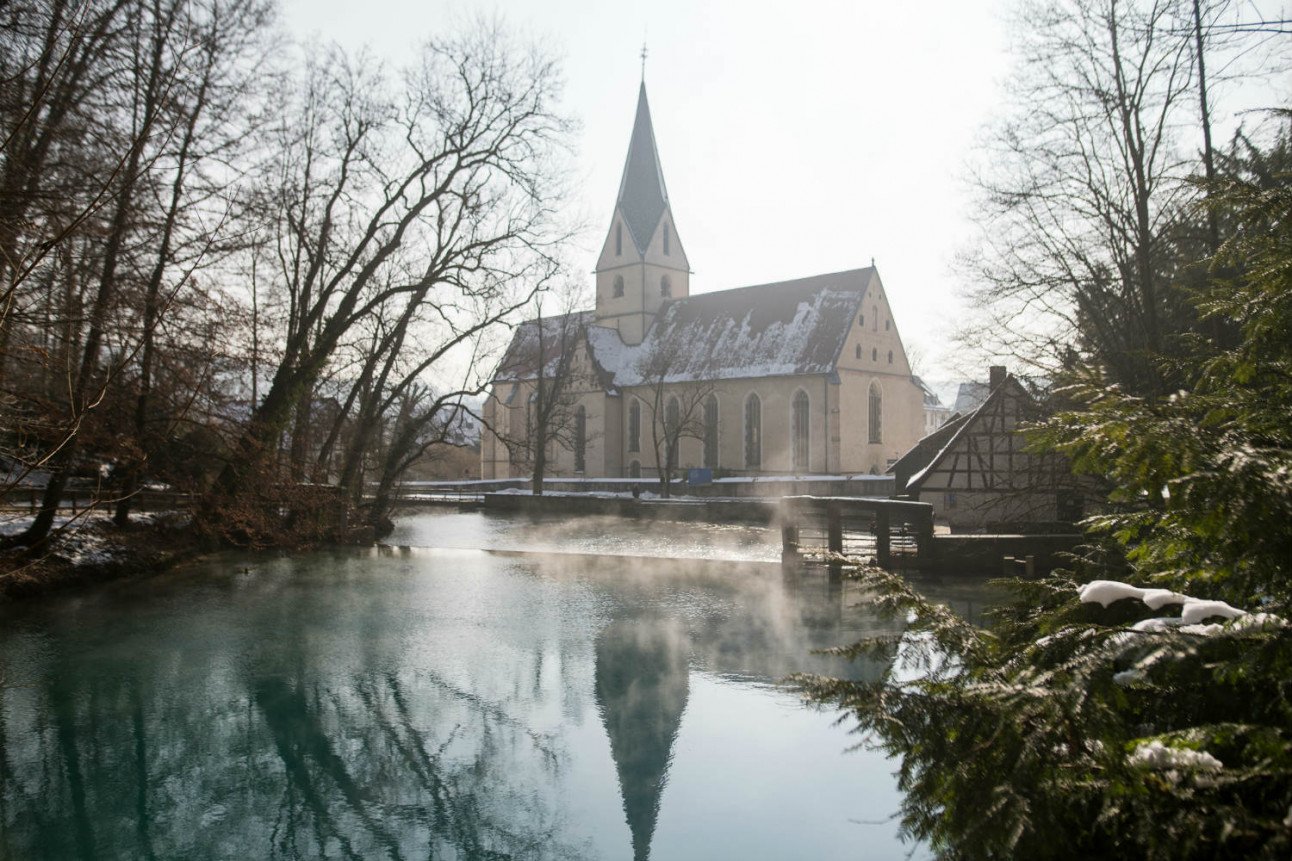Weekend Wanderlust: Why the town of Blaubeuren has Germany's bluest water

Parts of this German town may appear like a tropical lagoon, but really are remnants of an fascinating prehistoric history.
It’s hard to believe when you get off the train at Blaubeuren, but everything that you see was once deep, deep underwater. Those limestone outcrops?
The remains of ancient sea creatures, such as the ammonites, can be found in vast numbers throughout the area's rocks. This is an area that has undergone great change over millions of years to create today’s beautiful scenery.
READ ALSO: Germany's most beautiful beaches and lakes
That scenery is something that we humans have appreciated for a long time - around 42,000 years! Beginning in the early twentieth century, remains of human habitation have been found in caves surrounding the town, including carved figures and the earliest confirmed musical instrument ever found - a bone flute.

Inside a cave in Blaubeuren. Photo: DPA
The story of the region’s human prehistory is told at URMU - the Urgeschichtles Museum Blaubeuren (Museum of Prehistory). Items found at the region’s caves are on display here along with striking interpretive displays that explain the ingenuity of these ancestors of modern Germans.
The valley created by the hills surrounding Blaubeuren has been constantly inhabited since those early days, but it really grew to prominence in the high middle ages. An abbey was founded in 1085, an offshoot of the powerful monasteries at Maulbronn and Hirsau, and it grew to dominate the area until the Protestant Reformation.
The fact that it lay near several trade routes, a number of rivers and the powerful city of Ulm certainly didn’t hinder its growth.
READ ALSO: Travel in Germany: Discover centuries of riches in unmissable Ulm
Today, the immaculately preserved buildings of Kloster Blaubeuren stand as a testament of the power of the medieval church, and you can visit the church and bathhouse - built especially for the monks for a little luxury amongst the hours of prayer. Also make sure you see the spectacular high altar - a masterpiece of medieval wood carving.
It’s not the Kloster or the prehistoric past that brings tourists to Blaubeuren however - that distinction would have to go to the Blautopf. This natural spring, that is the source of the river Blau, is famed for its strikingly blue waters.
This is due to the unique properties of the limestone - when the sun strikes the water, the limestone reflects a vivid blue light on the visible spectrum, making it appear like some tropical lagoon. Visitors and picnickers have been coming here for at least two hundred years, to admire the natural beauty and enjoy a few refreshments in the sunshine.
It’s also a source of many local legends concerning spirits who make the spring their home. Most famously, the local poet and author, Eduard Mörike, incorporated these tales into his works, and a statue of a mermaid, one of his heroines, stands by the Blautopf to this day.

The 'Kloster' across a lake in the winter. Photo: DPA
The best way to see Blaubeuren, however, is by doing a circuit of the ‘Rundweg’, or circular path around the town, highlighted by signs bearing yellow circles.
While they will take you up several steep paths, the trek is rewarded by several spectacular outlooks, more than one ruined castle, and the famous ‘Küssende Sau’, a precarious rock formation that, funnily enough, looks just like two kissing pigs. Be sure to bring a water bottle and sturdy shoes!
Less than an hour from Stuttgart by car, and ten minutes by train from Ulm, Blaubeuren is a gorgeous slice of German landscape with a long and proud history. While it has been shaped over millions of years, and generations of human habitation, it will certainly provide a memorable afternoon or two for the curious and enthusiastic traveller.
Comments
See Also
It’s hard to believe when you get off the train at Blaubeuren, but everything that you see was once deep, deep underwater. Those limestone outcrops?
The remains of ancient sea creatures, such as the ammonites, can be found in vast numbers throughout the area's rocks. This is an area that has undergone great change over millions of years to create today’s beautiful scenery.
READ ALSO: Germany's most beautiful beaches and lakes
That scenery is something that we humans have appreciated for a long time - around 42,000 years! Beginning in the early twentieth century, remains of human habitation have been found in caves surrounding the town, including carved figures and the earliest confirmed musical instrument ever found - a bone flute.

Inside a cave in Blaubeuren. Photo: DPA
The story of the region’s human prehistory is told at URMU - the Urgeschichtles Museum Blaubeuren (Museum of Prehistory). Items found at the region’s caves are on display here along with striking interpretive displays that explain the ingenuity of these ancestors of modern Germans.
The valley created by the hills surrounding Blaubeuren has been constantly inhabited since those early days, but it really grew to prominence in the high middle ages. An abbey was founded in 1085, an offshoot of the powerful monasteries at Maulbronn and Hirsau, and it grew to dominate the area until the Protestant Reformation.
The fact that it lay near several trade routes, a number of rivers and the powerful city of Ulm certainly didn’t hinder its growth.
READ ALSO: Travel in Germany: Discover centuries of riches in unmissable Ulm
Today, the immaculately preserved buildings of Kloster Blaubeuren stand as a testament of the power of the medieval church, and you can visit the church and bathhouse - built especially for the monks for a little luxury amongst the hours of prayer. Also make sure you see the spectacular high altar - a masterpiece of medieval wood carving.
It’s not the Kloster or the prehistoric past that brings tourists to Blaubeuren however - that distinction would have to go to the Blautopf. This natural spring, that is the source of the river Blau, is famed for its strikingly blue waters.
This is due to the unique properties of the limestone - when the sun strikes the water, the limestone reflects a vivid blue light on the visible spectrum, making it appear like some tropical lagoon. Visitors and picnickers have been coming here for at least two hundred years, to admire the natural beauty and enjoy a few refreshments in the sunshine.
It’s also a source of many local legends concerning spirits who make the spring their home. Most famously, the local poet and author, Eduard Mörike, incorporated these tales into his works, and a statue of a mermaid, one of his heroines, stands by the Blautopf to this day.

The 'Kloster' across a lake in the winter. Photo: DPA
The best way to see Blaubeuren, however, is by doing a circuit of the ‘Rundweg’, or circular path around the town, highlighted by signs bearing yellow circles.
While they will take you up several steep paths, the trek is rewarded by several spectacular outlooks, more than one ruined castle, and the famous ‘Küssende Sau’, a precarious rock formation that, funnily enough, looks just like two kissing pigs. Be sure to bring a water bottle and sturdy shoes!
Less than an hour from Stuttgart by car, and ten minutes by train from Ulm, Blaubeuren is a gorgeous slice of German landscape with a long and proud history. While it has been shaped over millions of years, and generations of human habitation, it will certainly provide a memorable afternoon or two for the curious and enthusiastic traveller.
Join the conversation in our comments section below. Share your own views and experience and if you have a question or suggestion for our journalists then email us at [email protected].
Please keep comments civil, constructive and on topic – and make sure to read our terms of use before getting involved.
Please log in here to leave a comment.